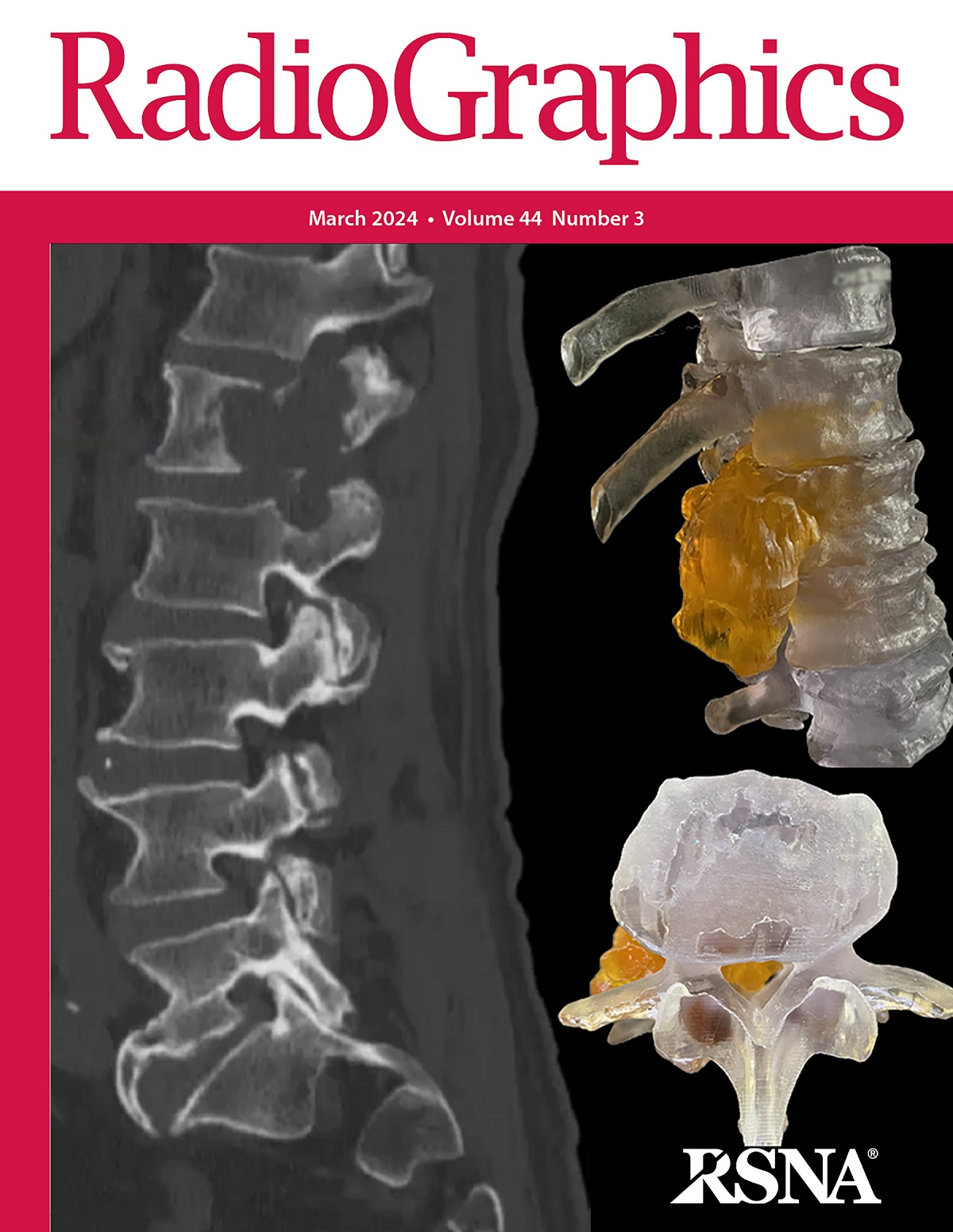Radiologic-Pathologic Correlation of Cardiac Tumors: Updated 2021 WHO Tumor Classification.
Maria Clara Lorca, Irene Chen, Gregory Jew, Andrea C Furlani, Savita Puri, Linda B Haramati, Apeksha Chaturvedi, Moises J Velez, Abhishek Chaturvedi
求助PDF
{"title":"Radiologic-Pathologic Correlation of Cardiac Tumors: Updated 2021 WHO Tumor Classification.","authors":"Maria Clara Lorca, Irene Chen, Gregory Jew, Andrea C Furlani, Savita Puri, Linda B Haramati, Apeksha Chaturvedi, Moises J Velez, Abhishek Chaturvedi","doi":"10.1148/rg.230126","DOIUrl":null,"url":null,"abstract":"<p><p>Cardiac tumors, although rare, carry high morbidity and mortality rates. They are commonly first identified either at echocardiography or incidentally at thoracoabdominal CT performed for noncardiac indications. Multimodality imaging often helps to determine the cause of these masses. Cardiac tumors comprise a distinct category in the World Health Organization (WHO) classification of tumors. The updated 2021 WHO classification of tumors of the heart incorporates new entities and reclassifies others. In the new classification system, papillary fibroelastoma is recognized as the most common primary cardiac neoplasm. Pseudotumors including thrombi and anatomic variants (eg, crista terminalis, accessory papillary muscles, or coumadin ridge) are the most common intracardiac masses identified at imaging. Cardiac metastases are substantially more common than primary cardiac tumors. Although echocardiography is usually the first examination, cardiac MRI is the modality of choice for the identification and characterization of cardiac masses. Cardiac CT serves as an alternative in patients who cannot tolerate MRI. PET performed with CT or MRI enables metabolic characterization of malignant cardiac masses. Imaging individualized to a particular tumor type and location is crucial for treatment planning. Tumor terminology changes as our understanding of tumor biology and behavior evolves. Familiarity with the updated classification system is important as a guide to radiologic investigation and medical or surgical management. <sup>©</sup>RSNA, 2024 <i>Supplemental material is available for this article.</i></p>","PeriodicalId":54512,"journal":{"name":"Radiographics","volume":"44 6","pages":"e230126"},"PeriodicalIF":5.2000,"publicationDate":"2024-06-01","publicationTypes":"Journal Article","fieldsOfStudy":null,"isOpenAccess":false,"openAccessPdf":"","citationCount":"0","resultStr":null,"platform":"Semanticscholar","paperid":null,"PeriodicalName":"Radiographics","FirstCategoryId":"3","ListUrlMain":"https://doi.org/10.1148/rg.230126","RegionNum":1,"RegionCategory":"医学","ArticlePicture":[],"TitleCN":null,"AbstractTextCN":null,"PMCID":null,"EPubDate":"","PubModel":"","JCR":"Q1","JCRName":"RADIOLOGY, NUCLEAR MEDICINE & MEDICAL IMAGING","Score":null,"Total":0}
引用次数: 0
引用
批量引用
Abstract
Cardiac tumors, although rare, carry high morbidity and mortality rates. They are commonly first identified either at echocardiography or incidentally at thoracoabdominal CT performed for noncardiac indications. Multimodality imaging often helps to determine the cause of these masses. Cardiac tumors comprise a distinct category in the World Health Organization (WHO) classification of tumors. The updated 2021 WHO classification of tumors of the heart incorporates new entities and reclassifies others. In the new classification system, papillary fibroelastoma is recognized as the most common primary cardiac neoplasm. Pseudotumors including thrombi and anatomic variants (eg, crista terminalis, accessory papillary muscles, or coumadin ridge) are the most common intracardiac masses identified at imaging. Cardiac metastases are substantially more common than primary cardiac tumors. Although echocardiography is usually the first examination, cardiac MRI is the modality of choice for the identification and characterization of cardiac masses. Cardiac CT serves as an alternative in patients who cannot tolerate MRI. PET performed with CT or MRI enables metabolic characterization of malignant cardiac masses. Imaging individualized to a particular tumor type and location is crucial for treatment planning. Tumor terminology changes as our understanding of tumor biology and behavior evolves. Familiarity with the updated classification system is important as a guide to radiologic investigation and medical or surgical management. © RSNA, 2024 Supplemental material is available for this article.
心脏肿瘤的放射病理学相关性:更新的 2021 年世界卫生组织肿瘤分类。
心脏肿瘤虽然罕见,但发病率和死亡率却很高。这些肿瘤通常在超声心动图检查中首次发现,或在因非心脏疾病而进行的胸腹部 CT 检查中偶然发现。多模态成像通常有助于确定这些肿块的病因。心脏肿瘤是世界卫生组织(WHO)肿瘤分类中的一个独特类别。2021 年更新的世界卫生组织心脏肿瘤分类纳入了新的实体,并对其他实体进行了重新分类。在新的分类系统中,乳头状纤维瘤被认为是最常见的原发性心脏肿瘤。假性肿瘤包括血栓和解剖变异(如末端嵴、附属乳头肌或库马丁脊),是影像学检查中发现的最常见的心脏内肿块。心脏转移瘤比原发性心脏肿瘤更为常见。虽然超声心动图通常是首选检查方法,但心脏核磁共振成像是识别和鉴定心脏肿块的首选方式。对于不能耐受核磁共振成像的患者,心脏 CT 可作为替代方法。正电子发射计算机断层扫描(PET)与 CT 或核磁共振成像一起进行,可确定恶性心脏肿块的代谢特征。针对特定肿瘤类型和位置的个体化成像对于制定治疗计划至关重要。随着我们对肿瘤生物学和行为的了解不断深入,肿瘤术语也在不断变化。熟悉最新的分类系统对于指导放射学检查和内外科治疗非常重要。©RSNA,2024 本文有补充材料。
本文章由计算机程序翻译,如有差异,请以英文原文为准。


